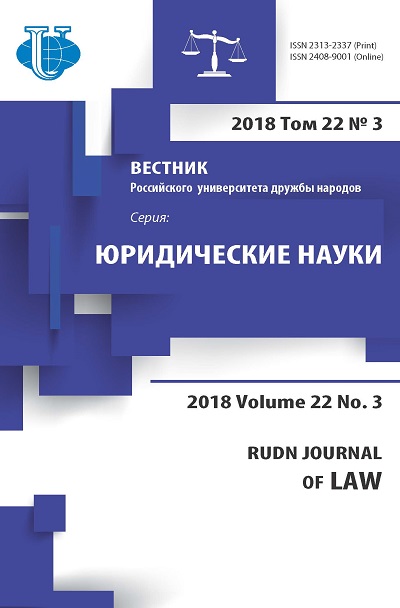State Control of the Interpretation of Genomic Studies and Medical Applications in the United States of America
- Authors: Sakhipgareeva A.R1
-
Affiliations:
- O.E. Kutafin Moscow State Juridical University (MSJU)
- Issue: Vol 22, No 3 (2018)
- Pages: 329-345
- Section: LAW AND DIGITAL TECHNOLOGIES
- URL: https://journals.rudn.ru/law/article/view/20772
- DOI: https://doi.org/10.22363/2313-2337-2018-22-3-329-345
- ID: 20772
Cite item
Full Text
Abstract
This Article is devoted to the theoretical ideas about the features of state control in genomic research and medical applications in the United States of America. The purpose of this study is to examine the legal aspects of the interpretation of genomic research and medical applications in the United States of America, to study the features of the state control of medical applications, as well as companies providing services in the field of genomic research. As a result of the review, the author provides with the information about several features of the state control of the US Food and drug administration (FDA), degree of regulatory intervention in the activities of genetic research companies, identify classification of medical applications apps.
Keywords
About the authors
Anzhelika R Sakhipgareeva
O.E. Kutafin Moscow State Juridical University (MSJU)
Author for correspondence.
Email: sar.3472@yandex.ru
PhD student, Department of Administrative Law and Procedure of Kutafin Moscow State Law University (MSAL)
Sadovaya-Kudrinskaya st., 9, Moscow, Russia, 123995References
- Bloss, C. S., Schork, N. J. & Topol, E. J. N. (2011) Engl. J. Med. 364,.
- Clement, P.D., Tribe L.H. (2015) Laboratory testing services, as the practice of medicine, cannot be regulated as medical devices. Washington, DC: American Clinical Laboratory Association.
- ClinGen and Genetic Testing. N Engl J Med 373:14, 1376-1379.
- Department of Health and Human Services, Center for Devices and Radiological Health, Food and Drug Administration, Center for Biologics Evaluation Research (2014). Balancing premarket and postmarket data collection for devices subject to premarket approval: draft guidance. Silver Spring, MD: FDA.
- Dewey, F.E., Grove, M.E., Pan, C., et al (2014). Clinical interpretation and implications of whole-genome sequencing. JAMA;311:1035-1045.
- Donna, A. Messner, Jennifer, Al Naber, Pei Koay, Robert Cook-Deegan, Mary Majumder, Gail Javitt, Patricia Deverka, Rachel Dvoskin, Juli Bollinger, Margaret Curnutte, Subhashini Chandrasekharan, Amy McGuire. (2016) Barriers to clinical adoption of next generation sequencing: Perspectives of a policy Delphi panel. Applied & Translational Genomics 10, 19-24.
- Dorschner, M.O., Amendola, L.M., Turner, E.H., et al (2013). Actionable, pathogenic incidental findings in 1,000 participants’ exomes. Am J Hum Genet;93:631-640.
- Evans, J.P., Watson, M.S. (2015). Genetic testing and FDA regulation: overregulation threatens the emergence of genomic medicine. JAMA;313:669-670.
- Fares Al-Ejeh, Andrew V. Biankin (2016). Molecular Diagnostics: Translation from Discovery to Clinical Practice. Molecular Pathology in Cancer Research, 1-26.
- Francke, U. et al. PeerJ 1, e8 (2013).
- Green, R. C. et al. N. Engl. J. Med. 361, (2009).
- Institute of Medicine Committee on the Public Health Effectiveness of the FDA 510(k) (2011). Clearance Process. Medical devices and the public’s health: the FDA 510(k) clearance process at 35 years. Washington, DC: Institute of Medicine.
- Kaufman, D. J., Bollinger, J. M., Dvoskin, R. L. & Scott, J. A. J. Genet. Couns. 21, 422.
- Kohane, I.S., Hsing, M, Kong S.W. (2012). Taxonomizing, sizing, and overcoming the incidentalome. Genet Med;14. 399-404.
- Lautenbach, D. M., Christensen, K. D., Sparks, J. A. & Green, R. C. Annu. (2013). Rev. Genomics Hum. Genet. 14.
- Rehm, H.L., Bale, S.J., Bayrak-Toydemir P., (2013) et al. ACMG clinical laboratory standards for next-generation sequencing. Genet Med; 15:733-747.
- Shirts, B.H., Jacobson, A. Jarvik, G.P., Browning, B.L. (2014) Large numbers of individuals are required to classify and define risk for rare variants in known cancer risk genes. Genet Med; 16:529-534.
- Thompson, B.M. (15/01/2015) The LDT debate: understanding FDA’s jurisdiction over IVDs made at a clinical lab. Pharma MedTech Insights.
- Topol, E. (2012) The Creative Destruction of Medicine (Basic).
- U.S. Food and Drug Admin (2014) Mobile medical applications: guidance for industry and Food and Drug Administration staff (“MMA Guidance”).
- Wildavsky, А. The Politics of the Budgetary Process Aaron Wildavsky, The Politics of the Budgetary Process Joachim Wehner The Oxford Handbook of Classics in Public Policy and Administration;2015
Supplementary files















